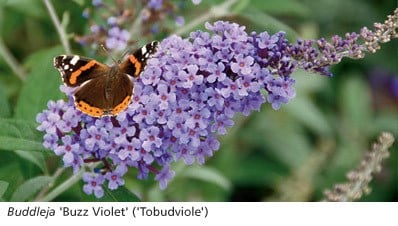Buddleja - the ultimate butterfly magnet
The best butterfly plant of all is the Buddleja, a shrubby plant with fingers of honey-scented flowers. When given a warm, sunny position it will ooze nectar from its slender flowers, which come in many colours. The most attractive to butterflies and bees are the purples, pinks, lavenders and pinkish reds. In theory, one single bush could attract and sustain twenty-two of our fifty-nine British species. That's more than any other plant. If you deadhead the spent flowers every few days, just as they begin to fade, new ones will appear giving you a couple of months of flower. This will also prevent unwanted seedlings popping up too.

Size varies widely, but if you have a smaller garden the diminutive Buzz series can be grown in a Buzz Violet’ has mauve flowers with tiny orange eyes and it will only grow to three feet in height. Add a slow release fertiliser in spring (such as Vitax Q4) straight after pruning, if it’s in a pot. Do not prune any Buddleja in autumn. Always wait until spring has arrived, because a hard winter could lead to losses.
 The slightly larger ‘Lochinch’ (found as a seedling in the Scottish garden of the same name) is also a refined Buddleja suitable for a smaller garden, because it grows slowly. The smallish grey-green leaves frame delicate heads of orange-eyed heliotrope-blue flowers. In milder gardens ‘Lochinch’ keeps its silvered leaves and makes a fine winter spectacle.
The slightly larger ‘Lochinch’ (found as a seedling in the Scottish garden of the same name) is also a refined Buddleja suitable for a smaller garden, because it grows slowly. The smallish grey-green leaves frame delicate heads of orange-eyed heliotrope-blue flowers. In milder gardens ‘Lochinch’ keeps its silvered leaves and makes a fine winter spectacle.
The giants of the Buddleja world are named forms of Buddleja davidii, a hardy Chinese species that has given rise to about a hundred varieties. Classics include ‘Royal Red’ (a 1940s’ selection and the closest to red) and the almost grape-black ‘Black Knight’, from 1959. Much newer is the spiraea-pink ‘Pink Delight’, which has enormous flower spikes. These larger buddlejas need hard pruning in spring to keep them compact, cutting back to the lowest buds. After this they will begin to flower in late July, on new growth. However, if grown at the back of herbaceous borders, it’s better to prune these buddlejas back by half. Then they will flower in early July, a full month earlier than hard-pruned plants.
Underplanting Buddlejas

Surround buddlejas with grey-leaved plants that tone with their grey-green foliage. Nepeta ‘Six Hill’s Giant’ produces a billowing haze of sterile blue flowers, so there are no unwanted seedlings. Cut it back and it will flower again within twenty days, perhaps less. The clean, lemon-yellow daisy, Anthemis tinctoria ‘E.C. Buxton’, provides a sharp contrast against the predominate blues, lavenders and purples of most buddlejas.






